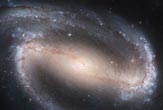ET Visitors: Scientists See High Likelihood
 Decades ago, it was physicist Enrico Fermi who pondered the issue of extraterrestrial
civilizations with fellow theorists over lunch, generating the famous quip:
"Where are they?" That question later became central to debates about
the cosmological census count of other star folk and possible extraterrestrial
(ET) visitors from afar.
Decades ago, it was physicist Enrico Fermi who pondered the issue of extraterrestrial
civilizations with fellow theorists over lunch, generating the famous quip:
"Where are they?" That question later became central to debates about
the cosmological census count of other star folk and possible extraterrestrial
(ET) visitors from afar.
Fermi's brooding on the topic was later labeled "Fermi's paradox." It is a well-traveled tale from the 1950's when the scientist broached the subject in discussions with colleagues in Los Alamos, New Mexico. Thoughts regarding the probability of earthlike planets, the rise of highly advanced civilizations "out there," and interstellar travel -- these remain fodder for trying to respond to Fermi's paradox even today.
Now a team of American scientists note that recent astrophysical discoveries suggest that we should find ourselves in the midst of one or more extraterrestrial civilizations. Moreover, they argue it is a mistake to reject all UFO reports since some evidence for the theoretically-predicted extraterrestrial visitors might just be found there.
The researchers make their proposal in the January/February 2005 issue of the Journal of the British Interplanetary Society (JBIS).
Curious situation
Pick up any good science magazine and you're sure to see the latest in head-scratching ideas about Superstring Theory, wormholes, or the stretching of space-time itself. Meanwhile, extra-solar planetary detection is on the verge of becoming mundane.
"We are in the curious situation today that our best modern physics and astrophysics theories predict that we should be experiencing extraterrestrial visitation, yet any possible evidence of such lurking in the UFO phenomenon is scoffed at within our scientific community," contends astrophysicist Bernard Haisch.
Haisch, along with physicists James Deardorff, Bruce Maccabee and Harold Puthoff, make their case in the JBIS article "Inflation-Theory Implications for Extraterrestrial Visitation."
The scientists point to two key discoveries made by Australian astronomers and reported last year that there is a "galactic habitable zone" in our Milky Way Galaxy--and more importantly that Earth's own star, the Sun, is relatively young in comparison to the average star in this zone -- by as much as a billion years.
Therefore, the researchers explain in their JBIS article that an average alien civilization would be far more advanced and have long since discovered Earth. Additionally, other research work on the supposition underlying the Big Bang -- known as the theory of inflation -- shores up the prospect, they advise, that our world is immersed in a much larger extraterrestrial civilization.
Point-to-point distances
Given billion-year advanced physics, might not buzzing around the galaxy be possible?
Even today Superstring Theory hypothesizes other dimensions, which could be habitable Universes adjacent to our own, the researchers speculate. It might even be possible to get around the speed of light limit by moving in and out of these dimensions.
"What we have done is somewhat of a breakthrough," Haisch told SPACE.com. "We have pulled together various recent discoveries and theoretical issues that collectively point to the strong probability that we should be in the midst of one or more huge extraterrestrial civilizations," he said.
Haisch said that superstring dimensions and wormhole and space-time stretching possibilities address the "can't get here from there" objection often argued in view of the interstellar, point-to-point distances involved. Also, diffusion models predict that even a single civilization could spread across the Galaxy in a tiny fraction of the age of the Galaxy - even at sub-light speeds, he said.
ET signature in the data
Can the scientific community bring itself to consider any evidence coming from mysterious sightings of strange things by the public?
In large measure, the scientific community seemingly has eyed ET visitation as far from being serious stuff to cogitate over. Why so?
"The dismissal has several causes, all reinforcing each other," Haisch responded. "Most of the observations are probably misinterpretations, delusions and hoaxes. I have seen people get confused by Venus or even Sirius when it is flashing colors low in the sky under the right conditions. Having been turned off by this, most scientists never bother to look any further and so are simply blissfully ignorant that there may be more to it," he said.
Deardorff, the lead author of the JBIS article, points out in a press statement: "It would take some humility for the scientific community to suspend its judgment and take at least some of the high quality reports seriously enough to investigate...but I hope we can bring ourselves to do that."
According to Haisch, there is a motivation not just for scientific tolerance of the UFO issue, but a strong scientific prediction that there ought to be some genuine ET signature in the data.
"This potentially changes the relationship of the UFO phenomenon to science in a significant way. It takes away the 'not invented here' prejudice, pointing out that a 'yes' to ET visitation is exactly what side our current physics and astrophysics theories would come down on as the most likely situation," Haisch concluded.
Source: http://www.space.com/searchforlife/et_betterodds_050114.html
By Leonard David
Senior Space Writer
14 January 2005